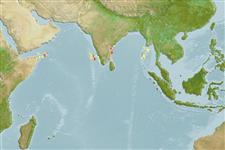Ελασμοβράγχιοι (καρχαρίες και σαλάχια) (sharks and rays) >
Carcharhiniformes (Ground sharks) >
Scyliorhinidae (Cat sharks) > Scyliorhininae
Etymology: Cephaloscyllium: cephalus, from kephale (Gr.), head, referring to its very broad and depressed head; skylion, Greek for dogfish or small shark (See ETYFish); silasi: In honor of Eric Godwin Silas (1928-2018), Sri Lankan-born Indian ichthyologist and fisheries scientist, Director, Central Marine Fisheries Institute (India), “whose excellent publications on the ichthyofauna of the continental shelf of the south-west coast of India have added much to our knowledge of the fauna of this region” (See ETYFish).
Eponymy: Dr Eric Godwin Silas (1928–2018) was a Sri Lankan-born Indian ichthyologist and fisheries scientist. [...] (Ref. 128868), visit book page.
Environment: milieu / climate zone / depth range / distribution range
Οικολογία
Θαλασσινό(ά) βαθύβιο(ς); εύρος βάθους 250 - 500 m (Ref. 95495). Deep-water; 16°N - 9°N
Western Indian Ocean: vicinity of Quilon, India (Ref. 244) and Sauqira Bay, Oman (Ref. 10914).
Μέγεθος / Βάρος / Age
Maturity: Lm ? range ? - 36.7 cm
Max length : 36.0 cm TL αρσενικό/απροσδιόριστο; (Ref. 95495); 45.0 cm TL (female)
Short description
Κλείδες προσδιορισμού | Μορφολογία | Μορφομετρία
This is a small shark with the following characters: stout body with expanded belly; labial furrows absent but a vestigial lower labial furrow may be present; anterior nasal flaps are broadly triangular; head depressed, flattened and broad, rounded in dorsal and ventrally; mouth large and arched; 5 gill slits, dorsolaterally placed and last two gill slits over pectorals, the 1-3 gill slits are subequal in length, 5th smallest; eyes dorsolateral and slit like; large mouth, arched or crescentic; mouth width 0.6 times HL; first dorsal origin slightly in front of pelvic insertion and placed above pelvics (Ref. 95495).
Found on the uppermost continental slope. Probably a dwarf species. Oviparous (Ref. 50499). This species could possibly attains a maximum size of 50.0 cm TL, with males reported (Ref. 26842) to reach length at maturity at 36.7 cm TL. A 45.0 cm female was found gravid and have two egg cases, one in each uterus, containing visible embryos (85.1-86.2 mm) with attached yolk sac. Stomach examined contains crustaceans and cephalopods (Ref. 95495).
Life cycle and mating behavior
Γεννητική Ωρίμανση | Αναπαραγωγή | Γεννοβολία | Αβγά | Γονιμότητα | Προνύμφες
Oviparous, paired eggs are laid. Embryos feed solely on yolk (Ref. 50449).
Compagno, L.J.V., 1984. FAO Species Catalogue. Vol. 4. Sharks of the world. An annotated and illustrated catalogue of shark species known to date. Part 2 - Carcharhiniformes. FAO Fish. Synop. 125(4/2):251-655. Rome: FAO. (Ref. 244)
IUCN Red List Status (Ref. 130435: Version 2024-2)
Threat to humans
Harmless
Human uses
αλιεία: χωρίς ενδιαφέρον
Εργαλεία
Special reports
Download XML
Διαδικτυακές πηγές
Estimates based on models
Phylogenetic diversity index (Ref.
82804): PD
50 = 0.5000 [Uniqueness, from 0.5 = low to 2.0 = high].
Bayesian length-weight: a=0.00263 (0.00138 - 0.00502), b=3.21 (3.04 - 3.38), in cm total length, based on LWR estimates for this (Sub)family-body shape (Ref.
93245).
Τροφικό Επίπεδο (Ref.
69278): 4.0 ±0.5 se; based on size and trophs of closest relatives
Ελαστικότητα (Ref.
120179): Χαμηλό, ελάχιστος χρόνος για διπλασιασμό πληθυσμού 4,5 - 14 έτη (Fec assumed to be <100).
Fishing Vulnerability (Ref.
59153): Low to moderate vulnerability (35 of 100).
